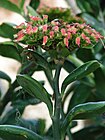Note: This is a project under development. The articles on this wiki are just being initiated and broadly incomplete. You can Help creating new pages.
Pedilanthus tithymaloides
Euphorbia tithymaloides is a perennial succulent spurge. An erect shrub, the plant is also known by the scientific name Pedilanthus tithymaloides. However, the genus Pedilanthus has been submerged into the genus Euphorbia, and is more correctly known by its new name (Euphorbia tithymaloides).
Contents
- 1 Uses
- 2 Parts Used
- 3 Chemical Composition
- 4 Common names
- 5 Properties
- 6 Habit
- 7 Identification
- 8 List of Ayurvedic medicine in which the herb is used
- 9 Where to get the saplings
- 10 Mode of Propagation
- 11 How to plant/cultivate
- 12 Commonly seen growing in areas
- 13 Photo Gallery
- 14 References
- 15 External Links
Uses
Emetic, Anti-inflammatory, Antibiotic, Antiseptic, Antihemorrhagic, Antiviral, Antitumoral, Abortive.
Parts Used
Chemical Composition
Leaves samples were processed to obtain extracts using hexane (Hex), ethyl acetate (EA) and ethanol (EtOH) by maceration. [1]
Common names
| Language | Common name |
|---|---|
| Kannada | |
| Hindi | |
| Malayalam | |
| Tamil | |
| Telugu | |
| Marathi | NA |
| Gujarathi | NA |
| Punjabi | NA |
| Kashmiri | NA |
| Sanskrit | |
| English | Devil's Backbone, Japanese Poinsettia, Slipper Spurge, Redbird Cactus, Christmas Candle |
Properties
Reference: Dravya - Substance, Rasa - Taste, Guna - Qualities, Veerya - Potency, Vipaka - Post-digesion effect, Karma - Pharmacological activity, Prabhava - Therepeutics.
Dravya
Rasa
Guna
Veerya
Vipaka
Karma
Prabhava
Habit
Identification
Leaf
| Kind | Shape | Feature |
|---|---|---|
| Simple | Acuminate in shape, With entire (smooth) edges. | The leaf is a simple angiosperm leaf, arranged oppositely on the stem. Each leaf is sessile (attaching directly to the plant), and about 1.4 to 3 inches (3.6 to 7.6 cm) in length. |
Flower
| Type | Size | Color and composition | Stamen | More information |
|---|---|---|---|---|
| Bisexual | Ovoid in shape | Pink | The seed pod is about 0.30 inches (7.6 mm) long and 0.35 inches (8.9 mm) wide, and ovoid in shape (with truncated ends). |
Other features
List of Ayurvedic medicine in which the herb is used
Where to get the saplings
Mode of Propagation
How to plant/cultivate
Pedilanthus tithymaloides houseplant likes bright indirect sunlight. Plant in direct sun in fall and winter, but give it a little protection from stinging hot rays in spring and summer. Just turning the slats on your blinds can be enough to keep the tips of the leaves from sizzling.
Read more at Gardening Know How: Devil’s Backbone Plant Info: How To Grow The Devil’s Backbone Plant Indoors https://www.gardeningknowhow.com/houseplants/devils-backbone/devils-backbone-plant.htm [3]
Commonly seen growing in areas
Photo Gallery
References
External Links
- Ayurvedic Herbs known to be helpful to treat Emetic
- Ayurvedic Herbs known to be helpful to treat Anti-inflammatory
- Ayurvedic Herbs known to be helpful to treat Antibiotic
- Ayurvedic Herbs known to be helpful to treat Antiseptic
- Ayurvedic Herbs known to be helpful to treat Antihemorrhagic
- Ayurvedic Herbs known to be helpful to treat Antiviral
- Ayurvedic Herbs known to be helpful to treat Antitumoral
- Ayurvedic Herbs known to be helpful to treat Abortive
- Herbs with Leaves used in medicine
- Herbs with Flower used in medicine
- Herbs with common name in English
- Habit - Herbs
- Index of Plants which can be propagated by Seeds
- Herbs that are commonly seen in the region of Lowland forest
- Herbs
- Euphorbiaceae



